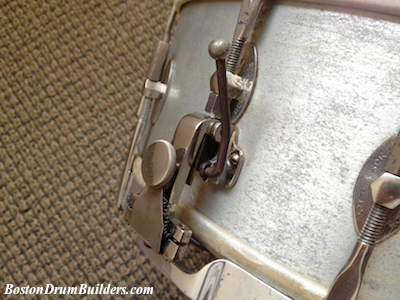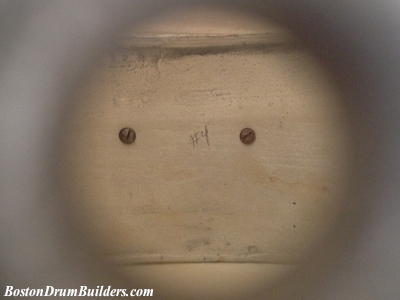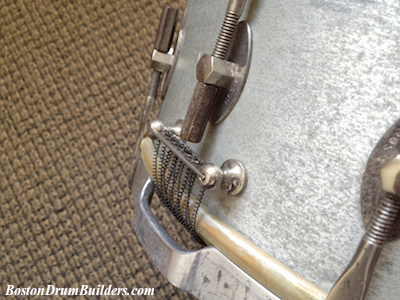
It's a mid 1920s George B. Stone & Son All-Metal Master-Model Drum. No such instrument is included in Stone Catalog K which was released around December of 1924. But a press release dated July 25, 1925 published by the Music Trade Review on August 1st of that year described the new drum as follows:
| Stone Announces New All-Metal Snare Drum
---- Made With Solid Aluminum Shell With Hoops to Match, This Being Selected After Many Experiments by Firm ---- BOSTON, MASS., July 25. - With the issue of a brank new Summer drum folder in colors, just off the press, containing many new items of interest to all drummers, George B. Stone & Son, Inc., drum makers, have introduced to the trade and profession a most remarkable all-metal snare drum constructed on the same scientific lines as their wood-shell Master-Model which is now so well-known to the trade and which is being used by so many of the better-known professional drummers to day, including Lopez Pennsylvanians, Mal Hallet, U. S. Jazz Band, Pryor's Band and many others of equal prominence. The new all-metal Master-Model drum is the result of long and careful study of different forms of metal and a solid aluminum shell with hoops to match was finally selected as being the least impervious to dampness and other weather conditions which cause the drummer so much worry. Many other features have been incorporated into this new drum and the immediate sales have indicated that this drum will soon take a place among the finest all-metal snare drums on the market. |
A Stone & Son poster size mailing indeed includes a picture and description of an All-Metal Master Model.
The example featured here fits the description in every way. The shell is made of solid aluminum and is painted silver. The aluminum, unfortunately, is beginning to oxidize giving the shell a less even appearance than when it was new. The hoops are also formed from aluminum but are polished to a shine and are not painted. The top hoop is slightly shorter than the bottom hoop and the bottom hoop has pronounced snare gates one of which is larger than the other. The remaining hardware is nickel plated and is all typical of mid - late 1920s Stone Master-Models. Interestingly, the all-metal version of the Master-Model utilizes only eight claws per head while their wooden shell brethren employ twelve each on top and bottom.
The drum sports a silver Master-Model badge which is tacked into the shell three panels to the left of the throw-off. There is a simple, unadorned metal grommet one more panel to the left. There is no paper label inside of the drum which is unusual for Stone. Instead, the number four is penciled on the shell and is visible through the air vent. This was either the fourth drum in a batch, or quite likely was only the fourth all-metal Master-Model to leave the factory. The workers at Stone & Son kept a running count of how many drums were being produced and while this drum bears no four-digit serial number, the hand written markings inside the shell are in keeping with those used by Stone on other drums.
Both heads were broken when I received the drum so new calfskins from Stern Tanning were tucked on the original flesh hoops. Interestingly, the flesh hoops were painted silver at the factory to match the shell! I know the paint is original because pencil markings over the paint indicated that these were a factory matched pair of flesh hoops. These markings, again, are in keeping with those seen on other Stone drums. The original wire snares were intact so they were cleaned and remounted. The drum is now in as close to original condition as possible and is ready to be proudly displayed.
 |  |
 |  |
| Do you have a antique George B. Stone & Son drum? I'd love to hear from you! Send Lee an email at lee@vinson.net. |








